Case Study: Developing Nurse-Patient Relationship with Riley
VerifiedAdded on 2022/09/07
|9
|2612
|16
Case Study
AI Summary
This case study centers on Riley Smithson, a 16-year-old boy admitted for diabetes testing, who also experiences nausea, fainting, polyuria, acne, social isolation, and mild depression. The assignment explores the factors impacting the nurse-patient therapeutic relationship, considering Riley's reluctance to communicate due to his physical and psychological issues, including his asthma and acne medication. The discussion delves into the current issues faced by Riley, including the psychological effects of diabetes, body image concerns, and social isolation, and the importance of addressing these issues. The case study emphasizes the development of a therapeutic relationship, suggesting strategies such as relatable communication, empathetic listening, and the use of technology to educate Riley about his condition. It also addresses the importance of involving Riley's parents in his care plan and outlines initial care priorities, including addressing Riley's psychological well-being, managing his diabetes through education and support, and ensuring he receives the appropriate therapeutic interventions. Ultimately, the case study concludes that by understanding Riley's struggles, communicating effectively, and involving his parents, the nurse can improve Riley's physical and psychological health.
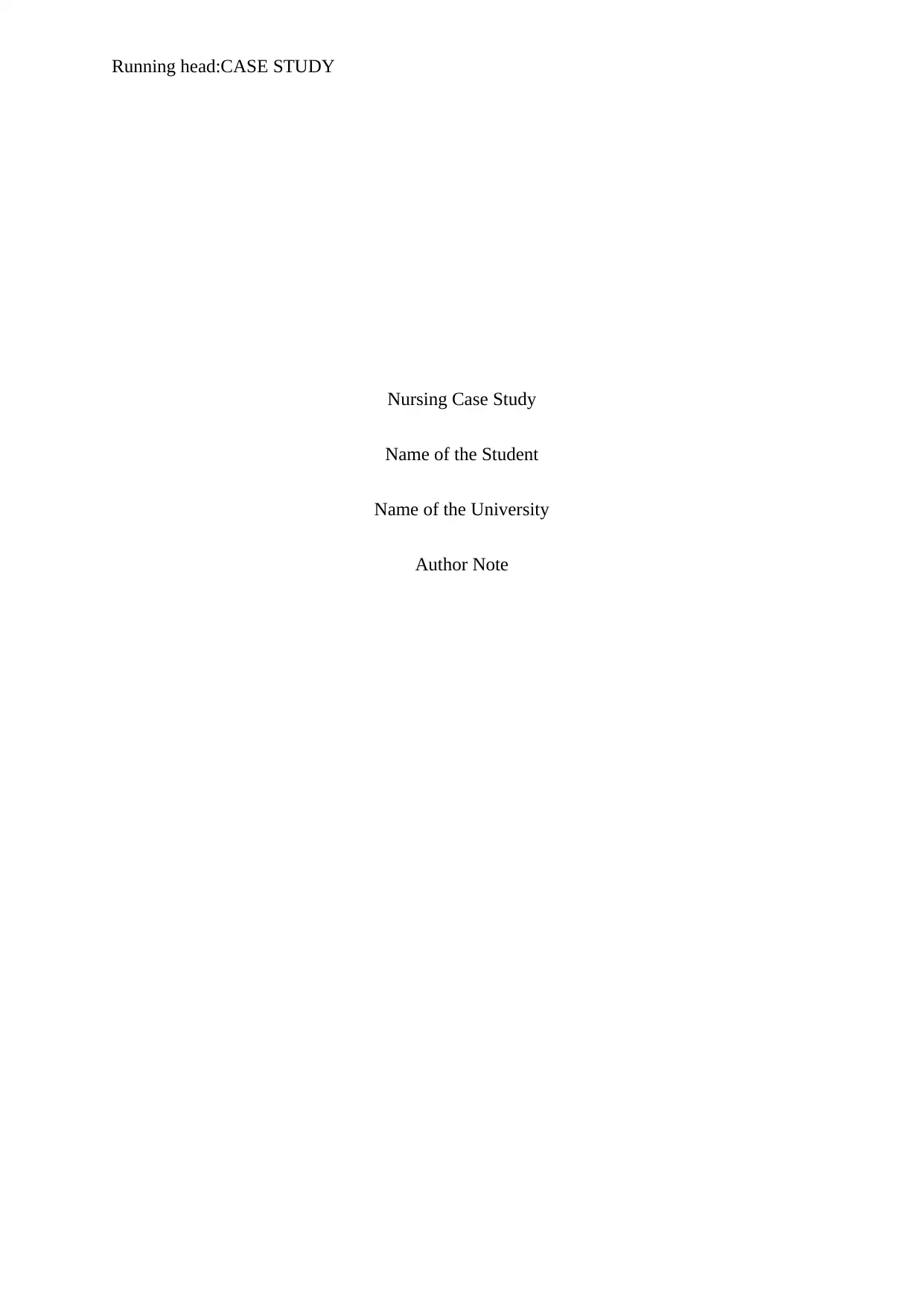
Running head:CASE STUDY
Nursing Case Study
Name of the Student
Name of the University
Author Note
Nursing Case Study
Name of the Student
Name of the University
Author Note
Secure Best Marks with AI Grader
Need help grading? Try our AI Grader for instant feedback on your assignments.
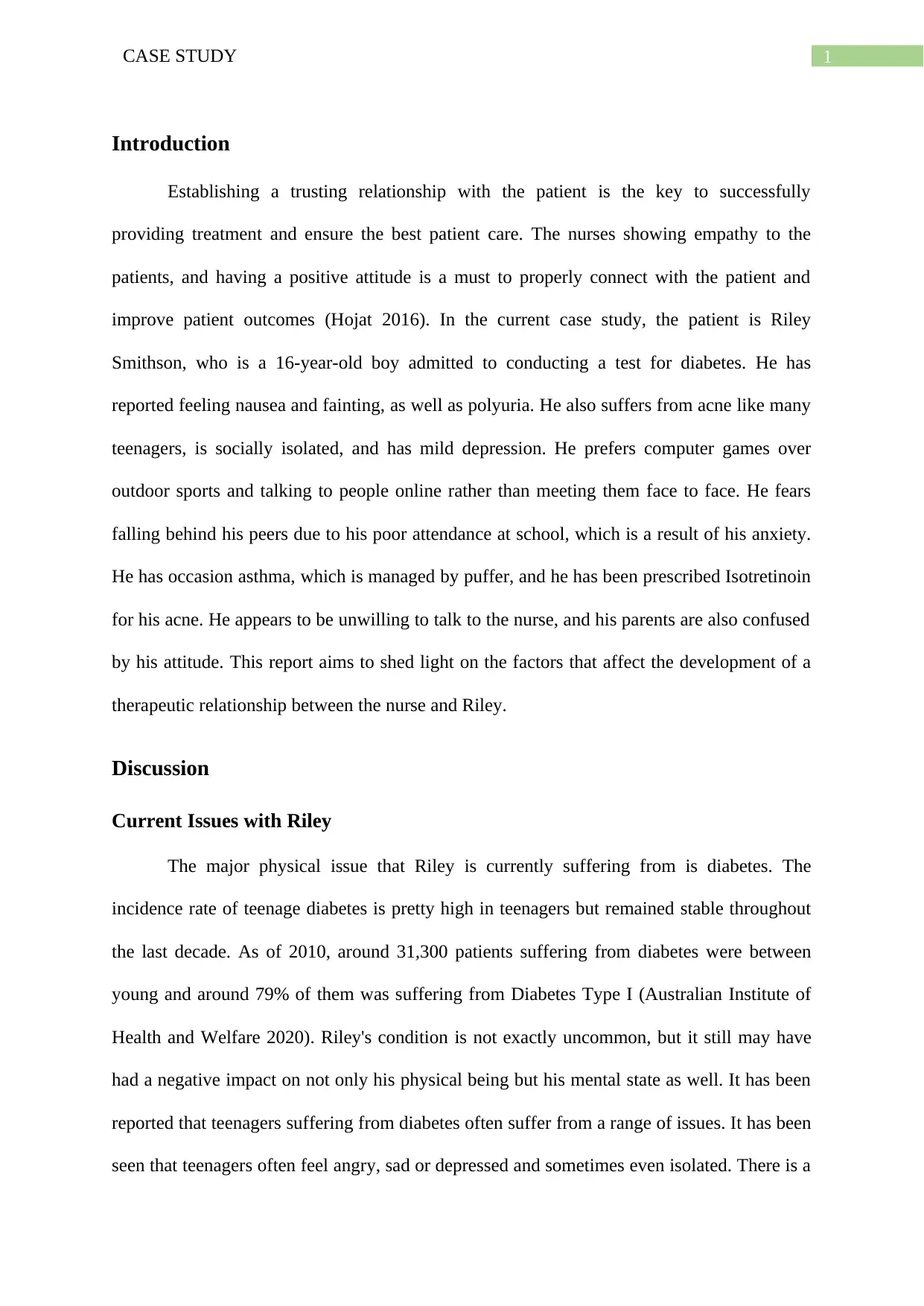
1CASE STUDY
Introduction
Establishing a trusting relationship with the patient is the key to successfully
providing treatment and ensure the best patient care. The nurses showing empathy to the
patients, and having a positive attitude is a must to properly connect with the patient and
improve patient outcomes (Hojat 2016). In the current case study, the patient is Riley
Smithson, who is a 16-year-old boy admitted to conducting a test for diabetes. He has
reported feeling nausea and fainting, as well as polyuria. He also suffers from acne like many
teenagers, is socially isolated, and has mild depression. He prefers computer games over
outdoor sports and talking to people online rather than meeting them face to face. He fears
falling behind his peers due to his poor attendance at school, which is a result of his anxiety.
He has occasion asthma, which is managed by puffer, and he has been prescribed Isotretinoin
for his acne. He appears to be unwilling to talk to the nurse, and his parents are also confused
by his attitude. This report aims to shed light on the factors that affect the development of a
therapeutic relationship between the nurse and Riley.
Discussion
Current Issues with Riley
The major physical issue that Riley is currently suffering from is diabetes. The
incidence rate of teenage diabetes is pretty high in teenagers but remained stable throughout
the last decade. As of 2010, around 31,300 patients suffering from diabetes were between
young and around 79% of them was suffering from Diabetes Type I (Australian Institute of
Health and Welfare 2020). Riley's condition is not exactly uncommon, but it still may have
had a negative impact on not only his physical being but his mental state as well. It has been
reported that teenagers suffering from diabetes often suffer from a range of issues. It has been
seen that teenagers often feel angry, sad or depressed and sometimes even isolated. There is a
Introduction
Establishing a trusting relationship with the patient is the key to successfully
providing treatment and ensure the best patient care. The nurses showing empathy to the
patients, and having a positive attitude is a must to properly connect with the patient and
improve patient outcomes (Hojat 2016). In the current case study, the patient is Riley
Smithson, who is a 16-year-old boy admitted to conducting a test for diabetes. He has
reported feeling nausea and fainting, as well as polyuria. He also suffers from acne like many
teenagers, is socially isolated, and has mild depression. He prefers computer games over
outdoor sports and talking to people online rather than meeting them face to face. He fears
falling behind his peers due to his poor attendance at school, which is a result of his anxiety.
He has occasion asthma, which is managed by puffer, and he has been prescribed Isotretinoin
for his acne. He appears to be unwilling to talk to the nurse, and his parents are also confused
by his attitude. This report aims to shed light on the factors that affect the development of a
therapeutic relationship between the nurse and Riley.
Discussion
Current Issues with Riley
The major physical issue that Riley is currently suffering from is diabetes. The
incidence rate of teenage diabetes is pretty high in teenagers but remained stable throughout
the last decade. As of 2010, around 31,300 patients suffering from diabetes were between
young and around 79% of them was suffering from Diabetes Type I (Australian Institute of
Health and Welfare 2020). Riley's condition is not exactly uncommon, but it still may have
had a negative impact on not only his physical being but his mental state as well. It has been
reported that teenagers suffering from diabetes often suffer from a range of issues. It has been
seen that teenagers often feel angry, sad or depressed and sometimes even isolated. There is a
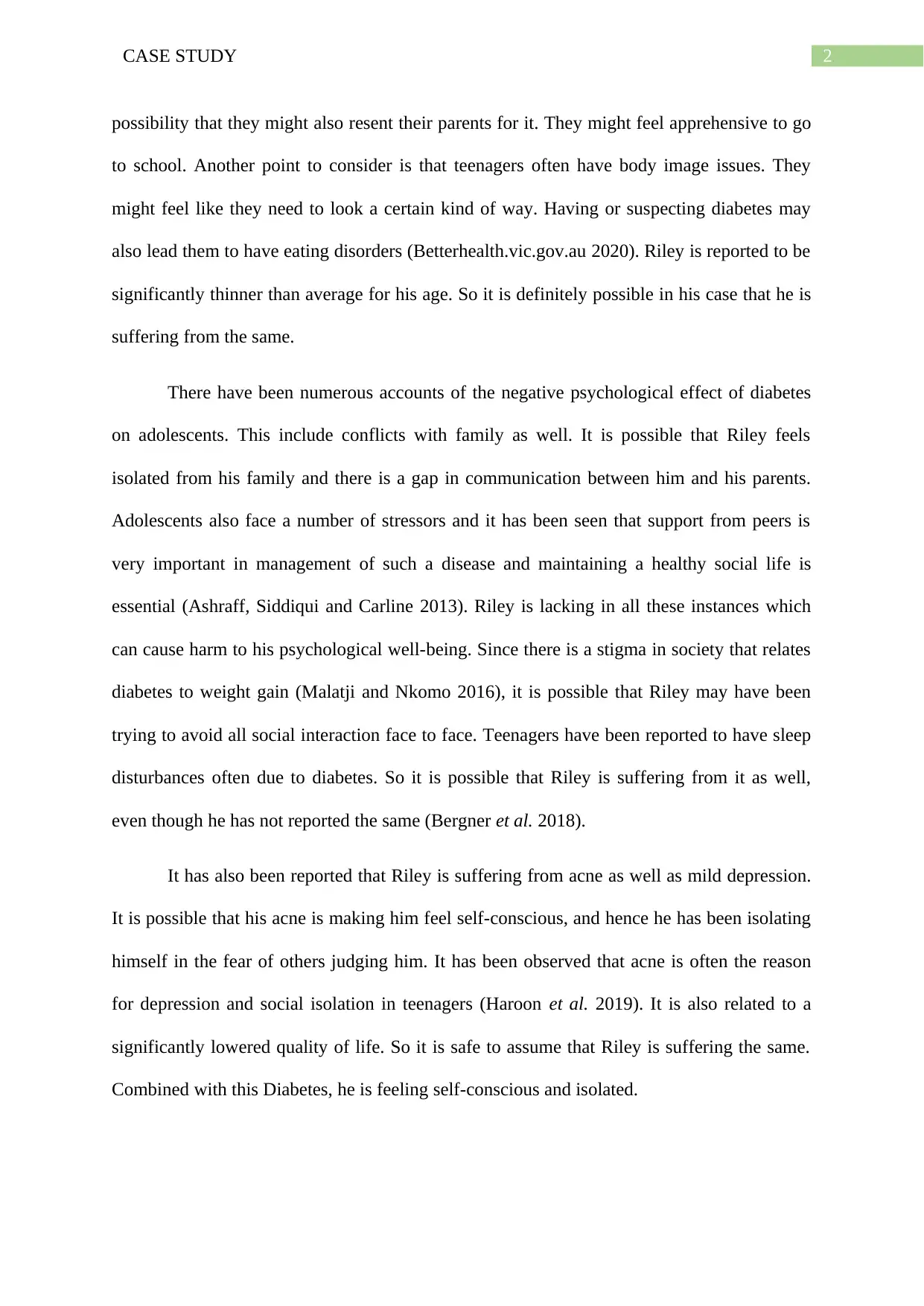
2CASE STUDY
possibility that they might also resent their parents for it. They might feel apprehensive to go
to school. Another point to consider is that teenagers often have body image issues. They
might feel like they need to look a certain kind of way. Having or suspecting diabetes may
also lead them to have eating disorders (Betterhealth.vic.gov.au 2020). Riley is reported to be
significantly thinner than average for his age. So it is definitely possible in his case that he is
suffering from the same.
There have been numerous accounts of the negative psychological effect of diabetes
on adolescents. This include conflicts with family as well. It is possible that Riley feels
isolated from his family and there is a gap in communication between him and his parents.
Adolescents also face a number of stressors and it has been seen that support from peers is
very important in management of such a disease and maintaining a healthy social life is
essential (Ashraff, Siddiqui and Carline 2013). Riley is lacking in all these instances which
can cause harm to his psychological well-being. Since there is a stigma in society that relates
diabetes to weight gain (Malatji and Nkomo 2016), it is possible that Riley may have been
trying to avoid all social interaction face to face. Teenagers have been reported to have sleep
disturbances often due to diabetes. So it is possible that Riley is suffering from it as well,
even though he has not reported the same (Bergner et al. 2018).
It has also been reported that Riley is suffering from acne as well as mild depression.
It is possible that his acne is making him feel self-conscious, and hence he has been isolating
himself in the fear of others judging him. It has been observed that acne is often the reason
for depression and social isolation in teenagers (Haroon et al. 2019). It is also related to a
significantly lowered quality of life. So it is safe to assume that Riley is suffering the same.
Combined with this Diabetes, he is feeling self-conscious and isolated.
possibility that they might also resent their parents for it. They might feel apprehensive to go
to school. Another point to consider is that teenagers often have body image issues. They
might feel like they need to look a certain kind of way. Having or suspecting diabetes may
also lead them to have eating disorders (Betterhealth.vic.gov.au 2020). Riley is reported to be
significantly thinner than average for his age. So it is definitely possible in his case that he is
suffering from the same.
There have been numerous accounts of the negative psychological effect of diabetes
on adolescents. This include conflicts with family as well. It is possible that Riley feels
isolated from his family and there is a gap in communication between him and his parents.
Adolescents also face a number of stressors and it has been seen that support from peers is
very important in management of such a disease and maintaining a healthy social life is
essential (Ashraff, Siddiqui and Carline 2013). Riley is lacking in all these instances which
can cause harm to his psychological well-being. Since there is a stigma in society that relates
diabetes to weight gain (Malatji and Nkomo 2016), it is possible that Riley may have been
trying to avoid all social interaction face to face. Teenagers have been reported to have sleep
disturbances often due to diabetes. So it is possible that Riley is suffering from it as well,
even though he has not reported the same (Bergner et al. 2018).
It has also been reported that Riley is suffering from acne as well as mild depression.
It is possible that his acne is making him feel self-conscious, and hence he has been isolating
himself in the fear of others judging him. It has been observed that acne is often the reason
for depression and social isolation in teenagers (Haroon et al. 2019). It is also related to a
significantly lowered quality of life. So it is safe to assume that Riley is suffering the same.
Combined with this Diabetes, he is feeling self-conscious and isolated.
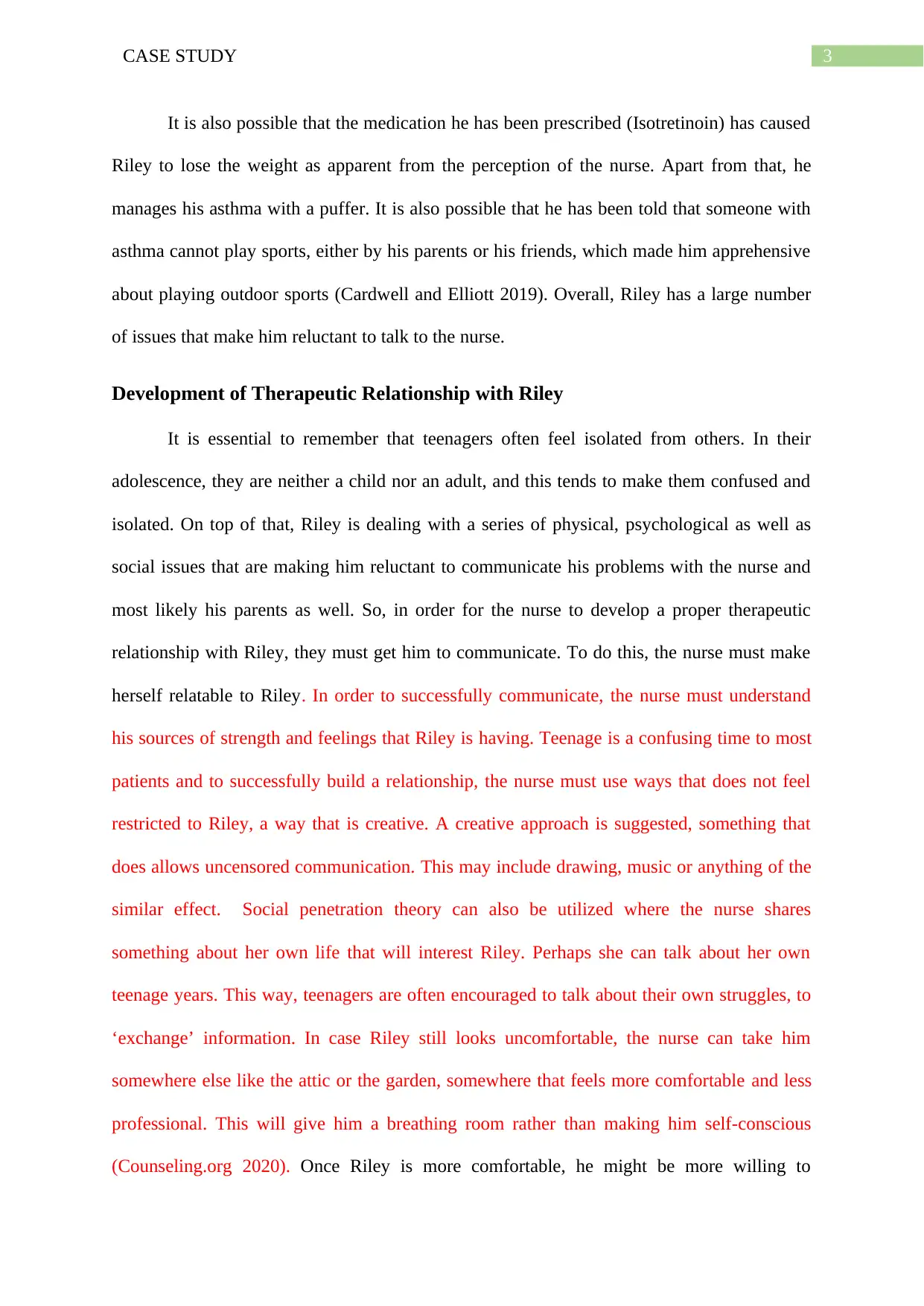
3CASE STUDY
It is also possible that the medication he has been prescribed (Isotretinoin) has caused
Riley to lose the weight as apparent from the perception of the nurse. Apart from that, he
manages his asthma with a puffer. It is also possible that he has been told that someone with
asthma cannot play sports, either by his parents or his friends, which made him apprehensive
about playing outdoor sports (Cardwell and Elliott 2019). Overall, Riley has a large number
of issues that make him reluctant to talk to the nurse.
Development of Therapeutic Relationship with Riley
It is essential to remember that teenagers often feel isolated from others. In their
adolescence, they are neither a child nor an adult, and this tends to make them confused and
isolated. On top of that, Riley is dealing with a series of physical, psychological as well as
social issues that are making him reluctant to communicate his problems with the nurse and
most likely his parents as well. So, in order for the nurse to develop a proper therapeutic
relationship with Riley, they must get him to communicate. To do this, the nurse must make
herself relatable to Riley. In order to successfully communicate, the nurse must understand
his sources of strength and feelings that Riley is having. Teenage is a confusing time to most
patients and to successfully build a relationship, the nurse must use ways that does not feel
restricted to Riley, a way that is creative. A creative approach is suggested, something that
does allows uncensored communication. This may include drawing, music or anything of the
similar effect. Social penetration theory can also be utilized where the nurse shares
something about her own life that will interest Riley. Perhaps she can talk about her own
teenage years. This way, teenagers are often encouraged to talk about their own struggles, to
‘exchange’ information. In case Riley still looks uncomfortable, the nurse can take him
somewhere else like the attic or the garden, somewhere that feels more comfortable and less
professional. This will give him a breathing room rather than making him self-conscious
(Counseling.org 2020). Once Riley is more comfortable, he might be more willing to
It is also possible that the medication he has been prescribed (Isotretinoin) has caused
Riley to lose the weight as apparent from the perception of the nurse. Apart from that, he
manages his asthma with a puffer. It is also possible that he has been told that someone with
asthma cannot play sports, either by his parents or his friends, which made him apprehensive
about playing outdoor sports (Cardwell and Elliott 2019). Overall, Riley has a large number
of issues that make him reluctant to talk to the nurse.
Development of Therapeutic Relationship with Riley
It is essential to remember that teenagers often feel isolated from others. In their
adolescence, they are neither a child nor an adult, and this tends to make them confused and
isolated. On top of that, Riley is dealing with a series of physical, psychological as well as
social issues that are making him reluctant to communicate his problems with the nurse and
most likely his parents as well. So, in order for the nurse to develop a proper therapeutic
relationship with Riley, they must get him to communicate. To do this, the nurse must make
herself relatable to Riley. In order to successfully communicate, the nurse must understand
his sources of strength and feelings that Riley is having. Teenage is a confusing time to most
patients and to successfully build a relationship, the nurse must use ways that does not feel
restricted to Riley, a way that is creative. A creative approach is suggested, something that
does allows uncensored communication. This may include drawing, music or anything of the
similar effect. Social penetration theory can also be utilized where the nurse shares
something about her own life that will interest Riley. Perhaps she can talk about her own
teenage years. This way, teenagers are often encouraged to talk about their own struggles, to
‘exchange’ information. In case Riley still looks uncomfortable, the nurse can take him
somewhere else like the attic or the garden, somewhere that feels more comfortable and less
professional. This will give him a breathing room rather than making him self-conscious
(Counseling.org 2020). Once Riley is more comfortable, he might be more willing to
Secure Best Marks with AI Grader
Need help grading? Try our AI Grader for instant feedback on your assignments.
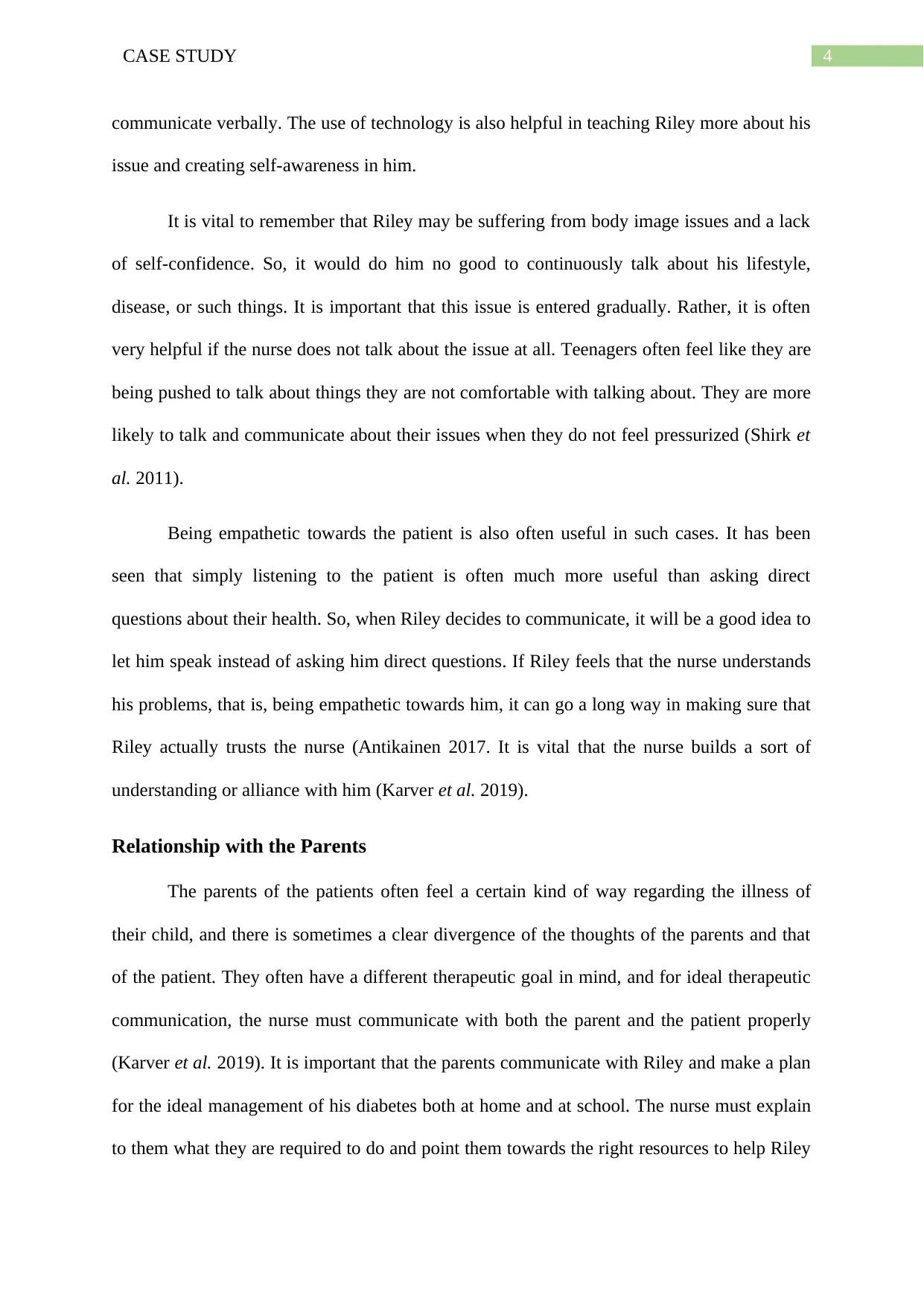
4CASE STUDY
communicate verbally. The use of technology is also helpful in teaching Riley more about his
issue and creating self-awareness in him.
It is vital to remember that Riley may be suffering from body image issues and a lack
of self-confidence. So, it would do him no good to continuously talk about his lifestyle,
disease, or such things. It is important that this issue is entered gradually. Rather, it is often
very helpful if the nurse does not talk about the issue at all. Teenagers often feel like they are
being pushed to talk about things they are not comfortable with talking about. They are more
likely to talk and communicate about their issues when they do not feel pressurized (Shirk et
al. 2011).
Being empathetic towards the patient is also often useful in such cases. It has been
seen that simply listening to the patient is often much more useful than asking direct
questions about their health. So, when Riley decides to communicate, it will be a good idea to
let him speak instead of asking him direct questions. If Riley feels that the nurse understands
his problems, that is, being empathetic towards him, it can go a long way in making sure that
Riley actually trusts the nurse (Antikainen 2017. It is vital that the nurse builds a sort of
understanding or alliance with him (Karver et al. 2019).
Relationship with the Parents
The parents of the patients often feel a certain kind of way regarding the illness of
their child, and there is sometimes a clear divergence of the thoughts of the parents and that
of the patient. They often have a different therapeutic goal in mind, and for ideal therapeutic
communication, the nurse must communicate with both the parent and the patient properly
(Karver et al. 2019). It is important that the parents communicate with Riley and make a plan
for the ideal management of his diabetes both at home and at school. The nurse must explain
to them what they are required to do and point them towards the right resources to help Riley
communicate verbally. The use of technology is also helpful in teaching Riley more about his
issue and creating self-awareness in him.
It is vital to remember that Riley may be suffering from body image issues and a lack
of self-confidence. So, it would do him no good to continuously talk about his lifestyle,
disease, or such things. It is important that this issue is entered gradually. Rather, it is often
very helpful if the nurse does not talk about the issue at all. Teenagers often feel like they are
being pushed to talk about things they are not comfortable with talking about. They are more
likely to talk and communicate about their issues when they do not feel pressurized (Shirk et
al. 2011).
Being empathetic towards the patient is also often useful in such cases. It has been
seen that simply listening to the patient is often much more useful than asking direct
questions about their health. So, when Riley decides to communicate, it will be a good idea to
let him speak instead of asking him direct questions. If Riley feels that the nurse understands
his problems, that is, being empathetic towards him, it can go a long way in making sure that
Riley actually trusts the nurse (Antikainen 2017. It is vital that the nurse builds a sort of
understanding or alliance with him (Karver et al. 2019).
Relationship with the Parents
The parents of the patients often feel a certain kind of way regarding the illness of
their child, and there is sometimes a clear divergence of the thoughts of the parents and that
of the patient. They often have a different therapeutic goal in mind, and for ideal therapeutic
communication, the nurse must communicate with both the parent and the patient properly
(Karver et al. 2019). It is important that the parents communicate with Riley and make a plan
for the ideal management of his diabetes both at home and at school. The nurse must explain
to them what they are required to do and point them towards the right resources to help Riley
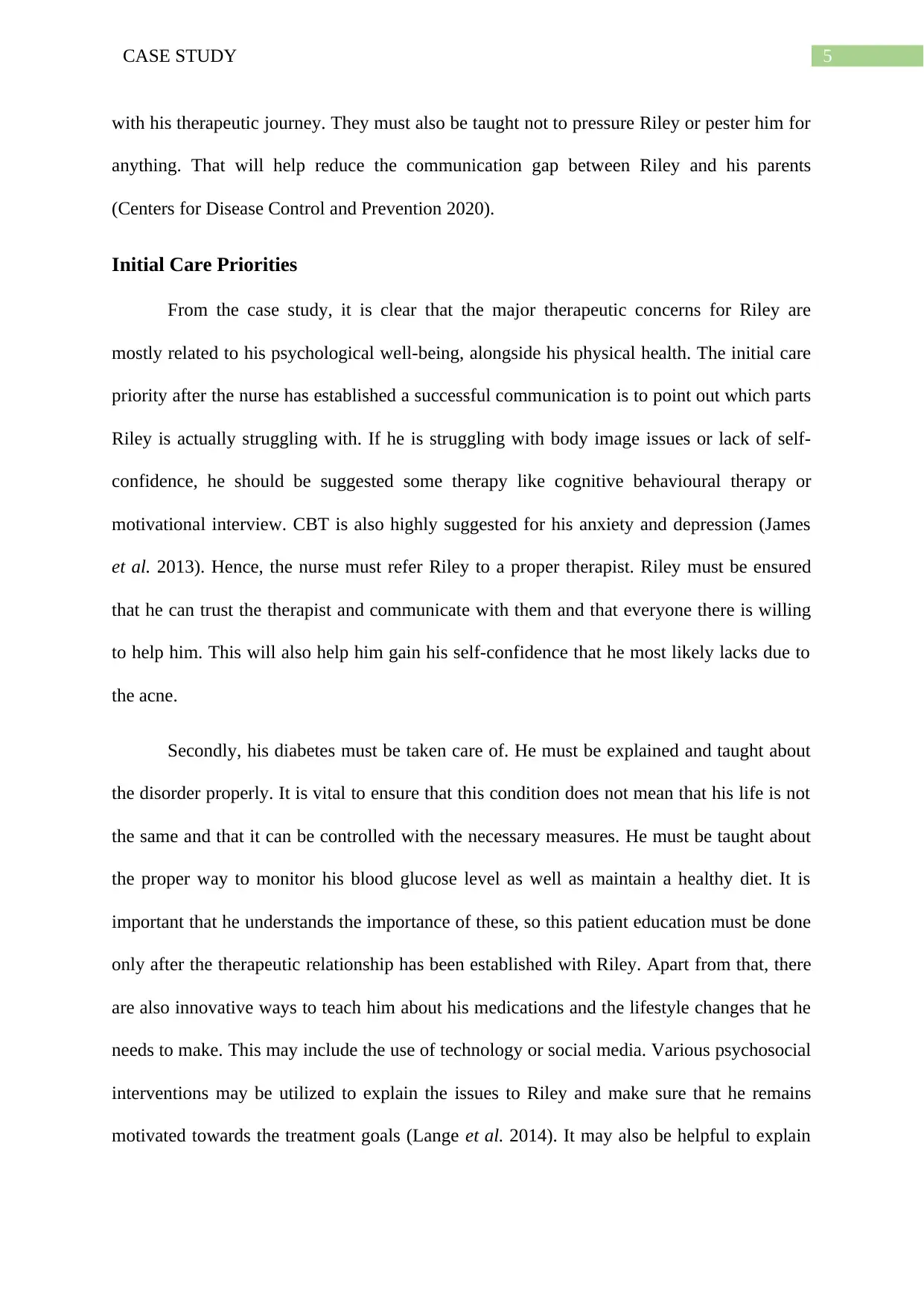
5CASE STUDY
with his therapeutic journey. They must also be taught not to pressure Riley or pester him for
anything. That will help reduce the communication gap between Riley and his parents
(Centers for Disease Control and Prevention 2020).
Initial Care Priorities
From the case study, it is clear that the major therapeutic concerns for Riley are
mostly related to his psychological well-being, alongside his physical health. The initial care
priority after the nurse has established a successful communication is to point out which parts
Riley is actually struggling with. If he is struggling with body image issues or lack of self-
confidence, he should be suggested some therapy like cognitive behavioural therapy or
motivational interview. CBT is also highly suggested for his anxiety and depression (James
et al. 2013). Hence, the nurse must refer Riley to a proper therapist. Riley must be ensured
that he can trust the therapist and communicate with them and that everyone there is willing
to help him. This will also help him gain his self-confidence that he most likely lacks due to
the acne.
Secondly, his diabetes must be taken care of. He must be explained and taught about
the disorder properly. It is vital to ensure that this condition does not mean that his life is not
the same and that it can be controlled with the necessary measures. He must be taught about
the proper way to monitor his blood glucose level as well as maintain a healthy diet. It is
important that he understands the importance of these, so this patient education must be done
only after the therapeutic relationship has been established with Riley. Apart from that, there
are also innovative ways to teach him about his medications and the lifestyle changes that he
needs to make. This may include the use of technology or social media. Various psychosocial
interventions may be utilized to explain the issues to Riley and make sure that he remains
motivated towards the treatment goals (Lange et al. 2014). It may also be helpful to explain
with his therapeutic journey. They must also be taught not to pressure Riley or pester him for
anything. That will help reduce the communication gap between Riley and his parents
(Centers for Disease Control and Prevention 2020).
Initial Care Priorities
From the case study, it is clear that the major therapeutic concerns for Riley are
mostly related to his psychological well-being, alongside his physical health. The initial care
priority after the nurse has established a successful communication is to point out which parts
Riley is actually struggling with. If he is struggling with body image issues or lack of self-
confidence, he should be suggested some therapy like cognitive behavioural therapy or
motivational interview. CBT is also highly suggested for his anxiety and depression (James
et al. 2013). Hence, the nurse must refer Riley to a proper therapist. Riley must be ensured
that he can trust the therapist and communicate with them and that everyone there is willing
to help him. This will also help him gain his self-confidence that he most likely lacks due to
the acne.
Secondly, his diabetes must be taken care of. He must be explained and taught about
the disorder properly. It is vital to ensure that this condition does not mean that his life is not
the same and that it can be controlled with the necessary measures. He must be taught about
the proper way to monitor his blood glucose level as well as maintain a healthy diet. It is
important that he understands the importance of these, so this patient education must be done
only after the therapeutic relationship has been established with Riley. Apart from that, there
are also innovative ways to teach him about his medications and the lifestyle changes that he
needs to make. This may include the use of technology or social media. Various psychosocial
interventions may be utilized to explain the issues to Riley and make sure that he remains
motivated towards the treatment goals (Lange et al. 2014). It may also be helpful to explain
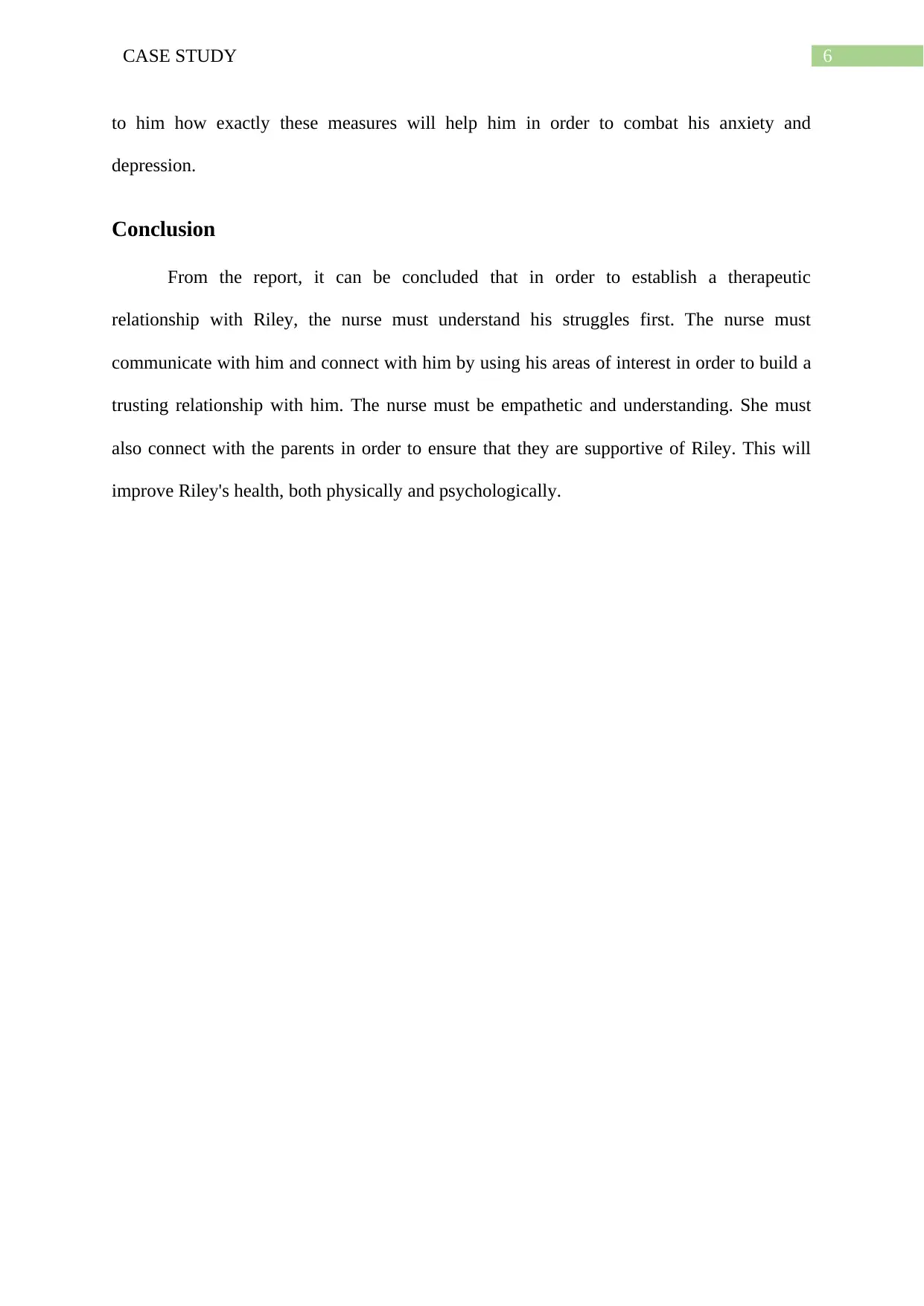
6CASE STUDY
to him how exactly these measures will help him in order to combat his anxiety and
depression.
Conclusion
From the report, it can be concluded that in order to establish a therapeutic
relationship with Riley, the nurse must understand his struggles first. The nurse must
communicate with him and connect with him by using his areas of interest in order to build a
trusting relationship with him. The nurse must be empathetic and understanding. She must
also connect with the parents in order to ensure that they are supportive of Riley. This will
improve Riley's health, both physically and psychologically.
to him how exactly these measures will help him in order to combat his anxiety and
depression.
Conclusion
From the report, it can be concluded that in order to establish a therapeutic
relationship with Riley, the nurse must understand his struggles first. The nurse must
communicate with him and connect with him by using his areas of interest in order to build a
trusting relationship with him. The nurse must be empathetic and understanding. She must
also connect with the parents in order to ensure that they are supportive of Riley. This will
improve Riley's health, both physically and psychologically.
Paraphrase This Document
Need a fresh take? Get an instant paraphrase of this document with our AI Paraphraser
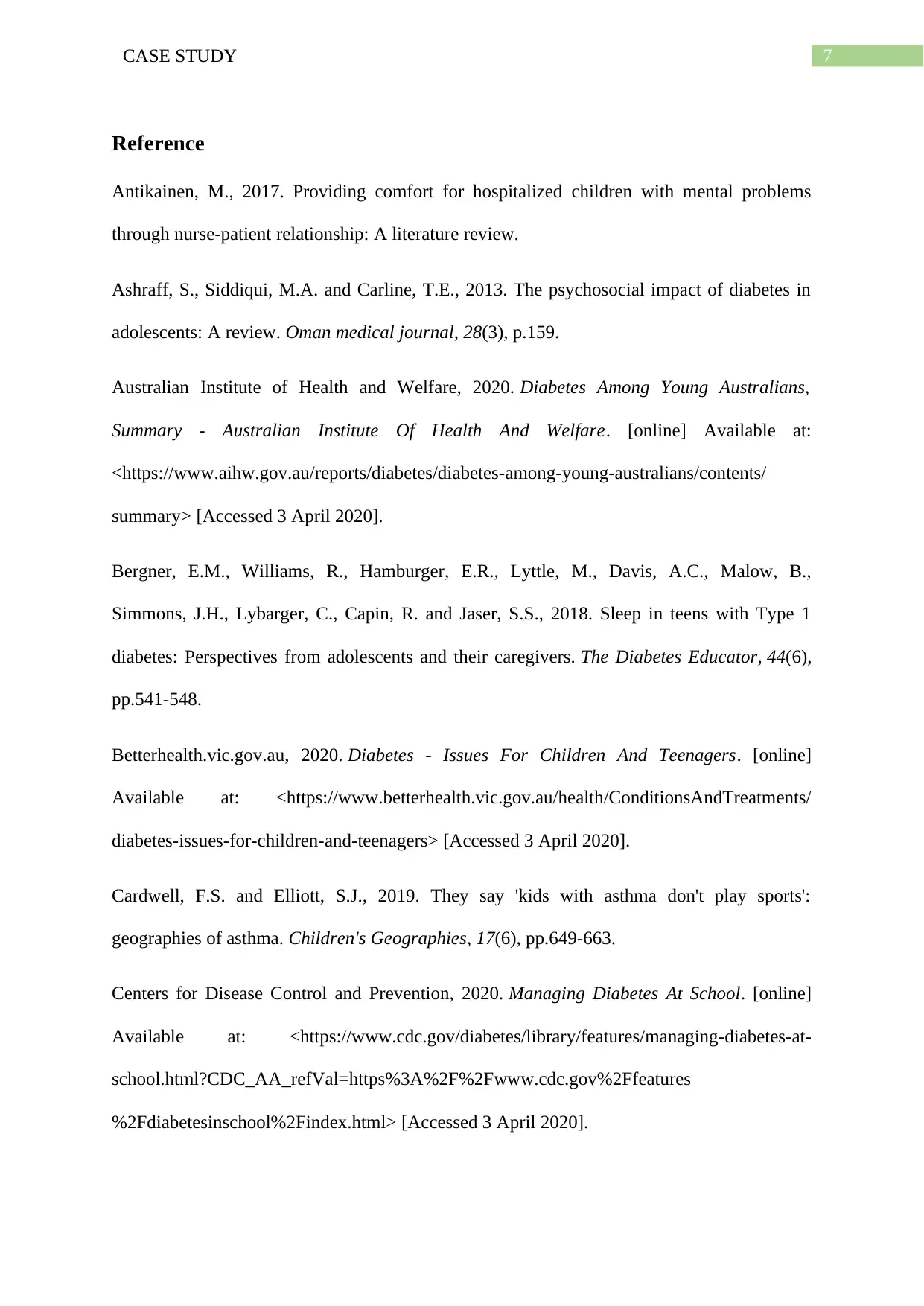
7CASE STUDY
Reference
Antikainen, M., 2017. Providing comfort for hospitalized children with mental problems
through nurse-patient relationship: A literature review.
Ashraff, S., Siddiqui, M.A. and Carline, T.E., 2013. The psychosocial impact of diabetes in
adolescents: A review. Oman medical journal, 28(3), p.159.
Australian Institute of Health and Welfare, 2020. Diabetes Among Young Australians,
Summary - Australian Institute Of Health And Welfare. [online] Available at:
<https://www.aihw.gov.au/reports/diabetes/diabetes-among-young-australians/contents/
summary> [Accessed 3 April 2020].
Bergner, E.M., Williams, R., Hamburger, E.R., Lyttle, M., Davis, A.C., Malow, B.,
Simmons, J.H., Lybarger, C., Capin, R. and Jaser, S.S., 2018. Sleep in teens with Type 1
diabetes: Perspectives from adolescents and their caregivers. The Diabetes Educator, 44(6),
pp.541-548.
Betterhealth.vic.gov.au, 2020. Diabetes - Issues For Children And Teenagers. [online]
Available at: <https://www.betterhealth.vic.gov.au/health/ConditionsAndTreatments/
diabetes-issues-for-children-and-teenagers> [Accessed 3 April 2020].
Cardwell, F.S. and Elliott, S.J., 2019. They say 'kids with asthma don't play sports':
geographies of asthma. Children's Geographies, 17(6), pp.649-663.
Centers for Disease Control and Prevention, 2020. Managing Diabetes At School. [online]
Available at: <https://www.cdc.gov/diabetes/library/features/managing-diabetes-at-
school.html?CDC_AA_refVal=https%3A%2F%2Fwww.cdc.gov%2Ffeatures
%2Fdiabetesinschool%2Findex.html> [Accessed 3 April 2020].
Reference
Antikainen, M., 2017. Providing comfort for hospitalized children with mental problems
through nurse-patient relationship: A literature review.
Ashraff, S., Siddiqui, M.A. and Carline, T.E., 2013. The psychosocial impact of diabetes in
adolescents: A review. Oman medical journal, 28(3), p.159.
Australian Institute of Health and Welfare, 2020. Diabetes Among Young Australians,
Summary - Australian Institute Of Health And Welfare. [online] Available at:
<https://www.aihw.gov.au/reports/diabetes/diabetes-among-young-australians/contents/
summary> [Accessed 3 April 2020].
Bergner, E.M., Williams, R., Hamburger, E.R., Lyttle, M., Davis, A.C., Malow, B.,
Simmons, J.H., Lybarger, C., Capin, R. and Jaser, S.S., 2018. Sleep in teens with Type 1
diabetes: Perspectives from adolescents and their caregivers. The Diabetes Educator, 44(6),
pp.541-548.
Betterhealth.vic.gov.au, 2020. Diabetes - Issues For Children And Teenagers. [online]
Available at: <https://www.betterhealth.vic.gov.au/health/ConditionsAndTreatments/
diabetes-issues-for-children-and-teenagers> [Accessed 3 April 2020].
Cardwell, F.S. and Elliott, S.J., 2019. They say 'kids with asthma don't play sports':
geographies of asthma. Children's Geographies, 17(6), pp.649-663.
Centers for Disease Control and Prevention, 2020. Managing Diabetes At School. [online]
Available at: <https://www.cdc.gov/diabetes/library/features/managing-diabetes-at-
school.html?CDC_AA_refVal=https%3A%2F%2Fwww.cdc.gov%2Ffeatures
%2Fdiabetesinschool%2Findex.html> [Accessed 3 April 2020].
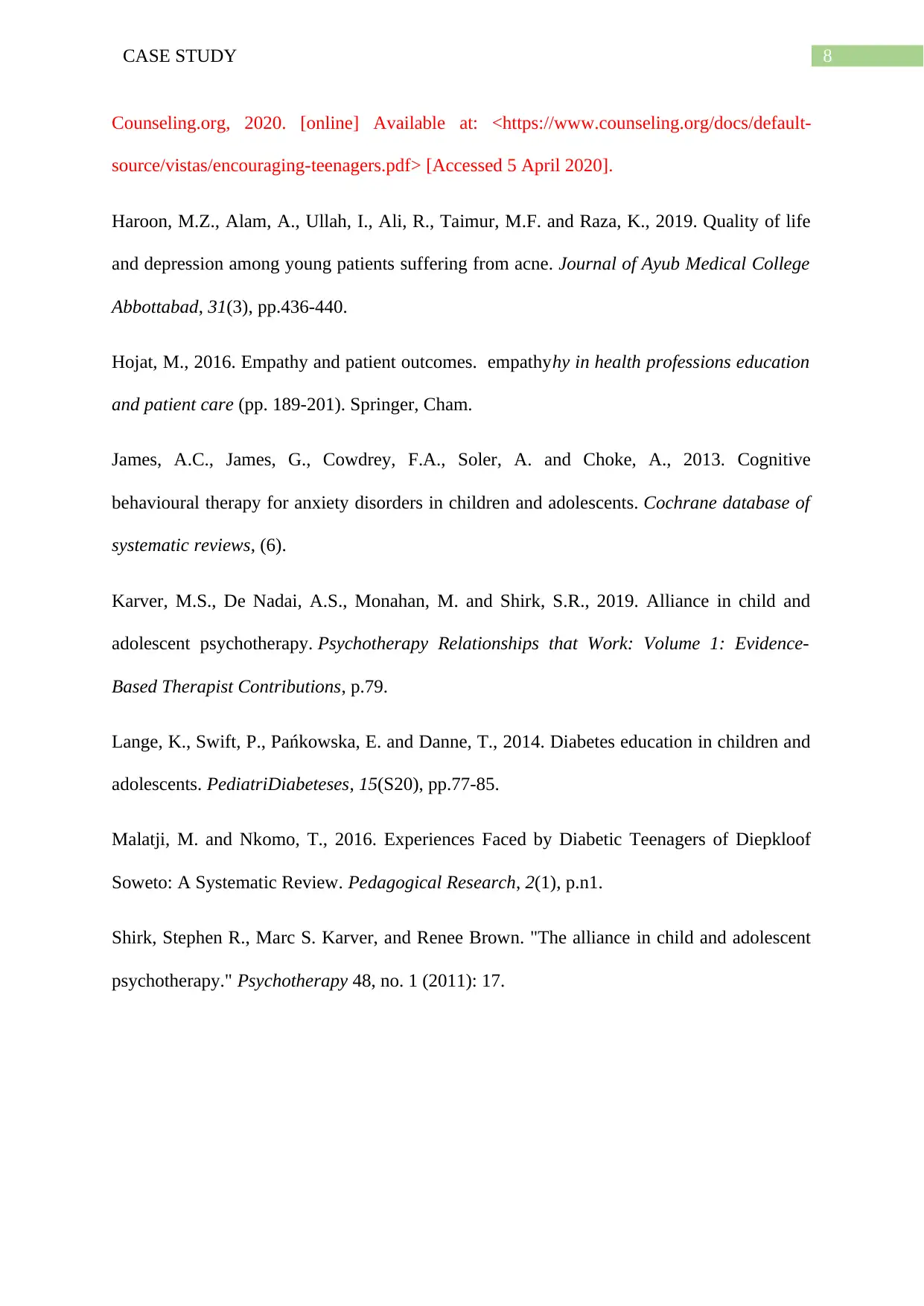
8CASE STUDY
Counseling.org, 2020. [online] Available at: <https://www.counseling.org/docs/default-
source/vistas/encouraging-teenagers.pdf> [Accessed 5 April 2020].
Haroon, M.Z., Alam, A., Ullah, I., Ali, R., Taimur, M.F. and Raza, K., 2019. Quality of life
and depression among young patients suffering from acne. Journal of Ayub Medical College
Abbottabad, 31(3), pp.436-440.
Hojat, M., 2016. Empathy and patient outcomes. empathyhy in health professions education
and patient care (pp. 189-201). Springer, Cham.
James, A.C., James, G., Cowdrey, F.A., Soler, A. and Choke, A., 2013. Cognitive
behavioural therapy for anxiety disorders in children and adolescents. Cochrane database of
systematic reviews, (6).
Karver, M.S., De Nadai, A.S., Monahan, M. and Shirk, S.R., 2019. Alliance in child and
adolescent psychotherapy. Psychotherapy Relationships that Work: Volume 1: Evidence-
Based Therapist Contributions, p.79.
Lange, K., Swift, P., Pańkowska, E. and Danne, T., 2014. Diabetes education in children and
adolescents. PediatriDiabeteses, 15(S20), pp.77-85.
Malatji, M. and Nkomo, T., 2016. Experiences Faced by Diabetic Teenagers of Diepkloof
Soweto: A Systematic Review. Pedagogical Research, 2(1), p.n1.
Shirk, Stephen R., Marc S. Karver, and Renee Brown. "The alliance in child and adolescent
psychotherapy." Psychotherapy 48, no. 1 (2011): 17.
Counseling.org, 2020. [online] Available at: <https://www.counseling.org/docs/default-
source/vistas/encouraging-teenagers.pdf> [Accessed 5 April 2020].
Haroon, M.Z., Alam, A., Ullah, I., Ali, R., Taimur, M.F. and Raza, K., 2019. Quality of life
and depression among young patients suffering from acne. Journal of Ayub Medical College
Abbottabad, 31(3), pp.436-440.
Hojat, M., 2016. Empathy and patient outcomes. empathyhy in health professions education
and patient care (pp. 189-201). Springer, Cham.
James, A.C., James, G., Cowdrey, F.A., Soler, A. and Choke, A., 2013. Cognitive
behavioural therapy for anxiety disorders in children and adolescents. Cochrane database of
systematic reviews, (6).
Karver, M.S., De Nadai, A.S., Monahan, M. and Shirk, S.R., 2019. Alliance in child and
adolescent psychotherapy. Psychotherapy Relationships that Work: Volume 1: Evidence-
Based Therapist Contributions, p.79.
Lange, K., Swift, P., Pańkowska, E. and Danne, T., 2014. Diabetes education in children and
adolescents. PediatriDiabeteses, 15(S20), pp.77-85.
Malatji, M. and Nkomo, T., 2016. Experiences Faced by Diabetic Teenagers of Diepkloof
Soweto: A Systematic Review. Pedagogical Research, 2(1), p.n1.
Shirk, Stephen R., Marc S. Karver, and Renee Brown. "The alliance in child and adolescent
psychotherapy." Psychotherapy 48, no. 1 (2011): 17.
1 out of 9
Related Documents
Your All-in-One AI-Powered Toolkit for Academic Success.
+13062052269
info@desklib.com
Available 24*7 on WhatsApp / Email
![[object Object]](/_next/static/media/star-bottom.7253800d.svg)
Unlock your academic potential
© 2024 | Zucol Services PVT LTD | All rights reserved.





